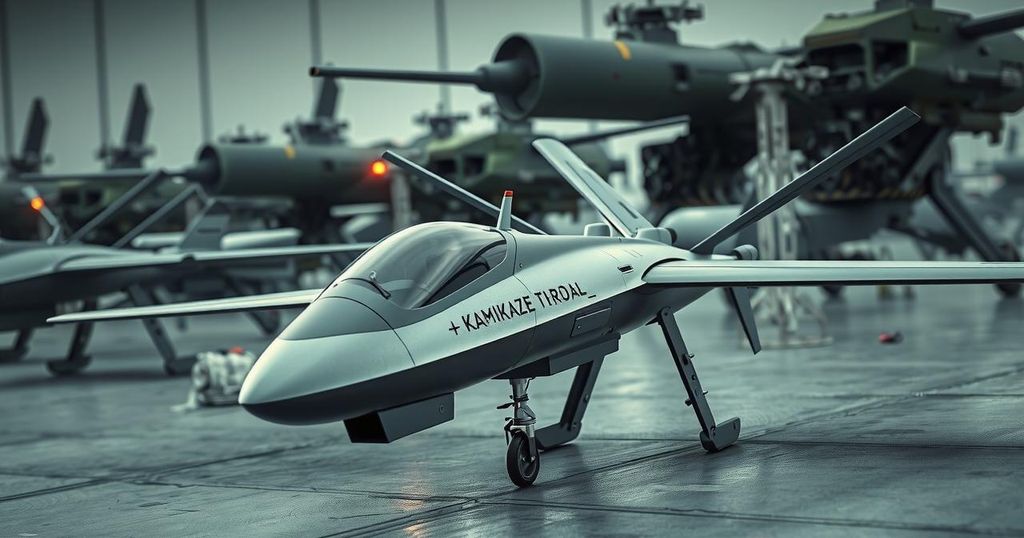India’s Drone Warfare: The Cost-Effective Strategy Against High-Tech Armaments

Kamikaze drones, costing around $500, are reshaping military dynamics by effectively targeting expensive assets like tanks, as evidenced in the Ukraine conflict. India is actively developing indigenous loitering munitions and autonomous drones to adapt to modern warfare demands. The challenge remains in keeping costs low and competing with foreign production while focusing on technological advancements in AI and drone capabilities for future conflicts.
Kamikaze drones, notably inexpensive options priced around $500, have dramatically reshaped modern warfare, especially against high-value assets like tanks. This trend is exemplified in the Ukraine conflict, where Russia’s Lancet-3 drones effectively target Ukrainian artillery. Conversely, Ukraine employs U.S.-made Switchblade drones, showcasing the pivotal role of loitering munitions in battlefield dynamics.
In the Middle East, Israel’s Harop drones carry a significant payload for precision strikes, while Iran’s Shahed-136 drones demonstrate the overwhelming efficacy of mass-produced drones against advanced air defense systems, challenging conventional warfare principles. Lt Gen Dhiraj Seth emphasized these insights during a seminar, stating that inexpensive drones are transforming military strategies.
Seth highlighted that a single $500 drone could potentially destroy a $10 million tank, establishing a formidable cost-effectiveness ratio of 20,000:1. He underscored the critical need for robust counter-drone systems, including electronic warfare measures and kinetic interceptors, to address this emerging threat landscape.
India recognizes the strategic importance of integrating loitering munitions into its military arsenal. The Indian Army is developing indigenous drones such as the SkyStriker, which has an impressive range of 500 km, and the Nagastra-1 tactical drone designed specifically for challenging terrain along the India-China border.
Private sector contributions are noteworthy, with firms like ZMotion and Tata Advanced Systems testing loitering munitions and VTOL drones, respectively, that promise cost-effectiveness and operational efficiency. Moreover, India’s Army showcased a capability to deploy 75 drone swarms for coordinated operations, a testament to the evolving approach in tactical warfare.
Research is advancing toward AI-driven drones capable of engaging enemy positions with precision. The National Aerospace Laboratories aims to deploy a long-range, stealthy loitering munition targeting capabilities up to 900 km, illustrating India’s commitment to cutting-edge technology in defense.
While India’s domestic drones are more affordable than Israeli models, they still lag behind Russian and Iranian variants in terms of cost. This disparity pressures Indian manufacturers to enhance innovation and lower production expenses. Concurrently, Western advancements, like the U.S.-born Hellhound S3, demonstrate the industry’s trend towards combining speed and affordability in drone technology.
India’s military modernization reflects a substantial shift, with 65% of defense equipment now produced domestically compared to a previous 70% dependency on imports. The defense sector experienced record production levels and significant export growth, with initiatives like iDEX fostering private sector innovation.
Nevertheless, challenges persist in competing against the ultra-low-cost drone manufacturing in Russia and Iran. Innovations in AI-driven UAV autonomy and the development of advanced loitering munitions are essential to maintaining a competitive edge. As tensions along its borders escalate, India is positioned to advance its technological capabilities as a strategic necessity.
In a world of rising geopolitical tensions, India’s investment in drone warfare illustrates a critical evolution in military strategy. As Lt Gen Seth noted, the battlefield paradigm has shifted toward unmanned systems. Thus, India is not only preparing for future conflicts; it is proactively reshaping the battlefield landscape.
India’s strategic emphasis on developing loitering munitions and drone technology represents a transformative shift in its military capabilities. By focusing on indigenous development and leveraging innovations from private sectors, India aims to enhance its defense against advanced military assets. The cost-efficiency presented by low-cost drones indicates a paradigm shift in warfare, marking a crucial development in the country’s approach to national security. As global dynamics evolve, India’s proactive steps in drone warfare highlight its commitment to maintaining defense superiority.
Original Source: m.economictimes.com







